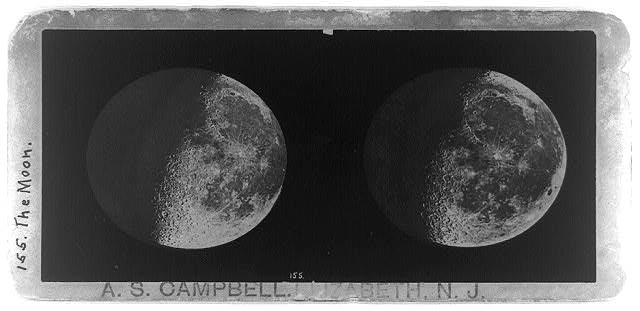Teach This Poem, though developed with a classroom in mind, can be easily adapted for remote learning, hybrid learning models, or in-person classes. Please see our suggestions for how to adapt this lesson for remote or blended learning. We have also noted suggestions when applicable and will continue to add to these suggestions online.

Campbell, Alfred S. The Moon., ca. 1896. Elizabeth, N.J.: A.S. Campbell. Photograph. https://www.loc.gov/item/93517418/.
The following activities and questions are designed to help your students use their noticing skills to move through the poem and develop their thinking about its meaning with confidence, using what they’ve noticed as evidence for their interpretations. Read more about the framework upon which these activities are based.
-
Warm-up: Look at the image of a photographic print of the moon. What do you notice? What does this image make you think about? Why?
-
Before Reading the Poem: (Teachers, to help students understand pantoums before class, print several copies of the poem or make a digital handout. Cut the poem into couplets and mix them up. Put students in groups and ask them to read the couplets and try to arrange them.) Work in your assigned groups to read the couplets and attempt to arrange them in some sort of order. As you do this, discuss anything that you notice about the lines or phrases. Read aloud your poem.
-
Reading the Poem: Read the poem “Music from Childhood” by John Yau silently. What do you notice about the poem? Annotate for any words or phrases that stand out to you or any questions you might have.
-
Listening to the Poem (ask two volunteers to read the poem aloud): Listen as the poem is read aloud twice, and write down any additional words and phrases that stand out to you. Or, you may opt to listen to the poet read the poem.
-
Small-group Discussion: Share what you noticed in the poem with a small group of students. Based on the details you just shared with your small group and the activities from the beginning of class, how did the sorting activity from the beginning of class compare to the printed poem? Think back to the image of the moon you viewed at the beginning of class. What are the differences in how you feel about the image of the photos of the moon, and how the moon is described in the poem by the speaker’s mother? What function does the photo serve? What function do the words in the poem serve?
-
Whole-class Discussion: How would you describe the speaker in this poem? Can you think of any words that “mourn the sounds buried inside their mouths”? What might this mean? How does the opening couplet compare to the final couplet?
-
Extension for Grades 7-8: Imagine that you’re telling a friend about this poem in the hopes that they will read it. How do you introduce this poem? What connections could you make to your own life to make this poem come alive? Continue reading more pantoums. Choose to write your own pantoum or use one of the couplets from the beginning of class to help you. Write a brief overview of what your strategy will be, including the reasoning for your choices.
-
Extension for Grades 9-12: Listen to The Slowdown episode in which the poet Tracy K. Smith introduces and then reads the poem. Explore other episodes of the podcast. (Teachers, you might want to give your students a list to choose from to help them decide.) Participate in a class discussion where you share and discuss your favorite episodes. How was your experience of listening to poetry being read aloud?
About this poem, John Yau writes, “‘Music from Childhood’ is a pantoum, which refers to the fact that I grew up in a household in which two languages were spoken. The repetition—and the fact that every line is repeated—seemed appropriate to the subject.” Read more.
